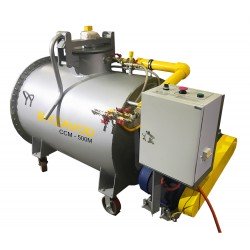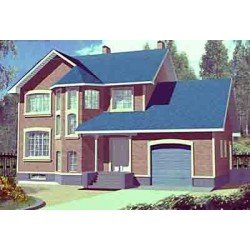
All technologies of production of various types of foam concrete consist in the production of porous and light concrete blocks, which are formed by introducing a special foam into the cement-sand mixture using unique equipment. This method of manufacturing foam concrete is called the method of wet mineralization. The foam used is pre-made in special equipment, which generates foam to be added to the mortar. This method of production has the advantage of a large range of different densities of the manufactured material. This is possible thanks to the precise dosing of the foam fed, right at the site of the construction operation.
Modern high-quality foam concrete, produced by the method of wet mineralization on special equipment, is used to pour a variety of structural elements and the formation of individual parts of the precast structure, which harden naturally or with the help of heat treatment. The most popular method of production is the production of non-autoclave curing foam concrete. This method does not require the use of additional equipment for the injection of high temperature and pressure, unlike the autoclaved aerated concrete, where the temperature must be in the range of 175-200 ° C, and the pressure is 0,8-1,3 MPa.
The use of foam concrete in construction has a number of advantages over other types of building materials
The main advantages of making foam concrete:
- the absence of fillers in the form of crushed stone, expanded clay, lime or gravel;
- The use of natural sand, which does not require additional processing;
- the maximum degree of mobility of the finished mixture, exceeding 60 cm, makes it possible to fill any shape and fill all the hidden cavities;
- no additional vibrating pouring processes are necessary; it allows filling of internal structural partitions and vertical formwork;
- small financial investments for the organization and implementation of the production of a variety of foam concrete elements for precast structures at the construction site or enterprise (you only need to have a foam generator and concentrate for the manufacture of foam - foaming agent);
- The use of special concrete pumps greatly simplifies the whole process of production and pouring;
- the ability to evenly distribute the finished mixture allows several times to reduce the cost of using additional equipment.
The use of foamed concrete for a variety of building purposes
The use of foam concrete in construction makes it possible to meet the much stricter requirements of modern standards, which are imposed on the indicators of thermal preservation of buildings. The high thermal insulation values of foam concrete are characterized by the specific structure of the material, which consists of small pores. They are formed as a result of the use of special equipment, which includes a mixer and a foam generator. These pores, distributed absolutely evenly throughout the entire volume of the material, have identical size and degree of closure, which exceeds 90%. Construction from foam concrete blocks has the highest indicators of comfort and internal coziness. Such buildings are distinguished by:
- a pleasant light coolness in the hot season;
- uniform heating of the entire thickness of the material;
- excellent rates of sound insulation (60 dB);
- an ideal surface for finishing decorative works;
- a high level of fire safety;
- excellent operation indicators;
- low degree of moisture absorption.
- Such merits of the material are inherent in all products of foam concrete mixes, which are made on the basis of protein blowing agents, in particular protein hydrolysates.
The use of protein blowing agents allows to achieve minimum indices of moisture absorption by the material. Among the representatives of aerated concrete, aerated concrete based on synthetic additives and aerated concrete based on protein blowing agents, the latter option absorbs the least amount of moisture for the longest period of time. This is easily verified by dipping all three samples into a container of water for a certain amount of time. Weighing all the samples will show the minimum absorption of moisture by the representative of foam concrete based on protein blowing agents, in particular protein hydrolysates. Such an experiment can be advantageously used as a unique marketing move when selling concrete blocks.
Due to the excellent thermal insulation of the material the walls of the building erected from foam concrete blocks can be significantly reduced in thickness.
The technology process of foam concrete production by the classical method of wet mineralization
The entire process of manufacturing foam concrete using the technology of wet mineralization with the use of special equipment in the form of a foam generator and mixer consists of four main steps. They include:
- Preparing and running the mixer, which mixes the basic elements, in the form of water, sand and cement. The process of mixing the cement-sand mortar lasts from 3 to 5 minutes.
- Without stopping the process of mixing the mortar, the foam is fed into the mixer from the foam generator, which has a certain degree of density. The foam process takes about one minute.
- All the components of the mixture are thoroughly mixed in the mixer for a couple of minutes.
- Then close the neck of the mixer and compressed air is fed, which contributes to the convenient transportation of the finished foam concrete to the place of filling, using a flexible system of elastic hoses.
The complete cycle of technological processes for the production of foam concrete takes from 7 to 12 minutes. Practical experience shows that the speed of foam concrete production depends on the overall intensity of the work and the degree of professionalism of the personnel performing certain functions.
The walls of the building, erected from foam concrete blocks can be plastered, painted or wallpapered, based on the requirements of the customer facility. Facades of the building, built with foam concrete, perfectly amenable to treatment of any type of finish. The most popular types of finishing foam concrete facades:
- painting with a special dispersion paint for facades with a high degree of water resistance;
- The application of a thin layer of decorative plaster;
- application of a variety of primers on the basis of sand mixtures;
- laying in the form of a block of tiles for facing before pouring the foam concrete;
- drawing of a textured layer of small stones, pebbles and various kinds of crumbs;
- adding special coloring pigments to the foam concrete mixture before pouring.
Construction process of the individual elements of the precast structure
In a project that does not include formwork, the overall construction of the building by monolithic method is carried out by connecting individual parts of the precast construction elements of foam concrete. Such elements can be produced in the manufacturing plant or directly on the construction site of the facility.
Foam concrete blocks of grade D600, which are characterized by high rates of thermal insulation structure has a compressive strength of 20-25 kg per square centimeter. For the manufacture of the highest quality foam concrete blocks, which are called bioblocs, requires up to 310 kg of cement M500, about 220 kg of pure sand with a fraction of 3 mm and 1.15 kg of foam.
Production of non-autoclave curing foam concrete complies with all standards and requirements of the current GOST 25485-89.

























